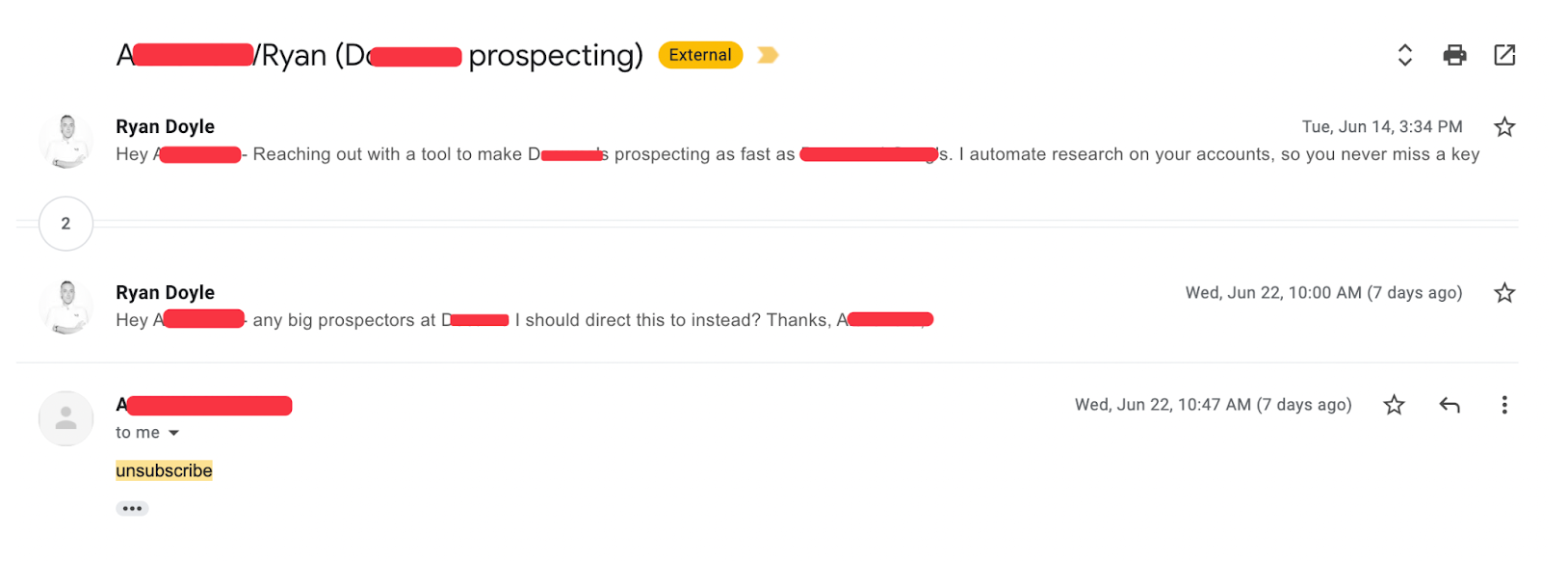There’s those few aspirational companies that we deeply want to work with. Their logo on our site would show everyone that we’re #1 at what we do. Their signature on our paper would be a talking point for the rest of our sales career. The commission from the deal wouldn’t hurt either.
So what do we do when they say they’re not interested in speaking with us? Or even worse, you pour your heart into content, and you get this?

Win your dream customers: Playing the long game
We have our prescribed lists and territories. Out of that list, we need a few things:
- Short term opportunities (what can close in-quarter?)
- Long term opportunities (what am I setting up for next quarter?)
- Moonshots (what customers would mean the world to us?)
We want to keep going after our dream customers (our moonshots). Still, we need to balance that out with opportunities that will keep us at quota. The longer we stay employed, the better shot we have of winning our customers over the long term.
You’ll find your own time balance, but I found that my time focused on:
- 50% short-term
- 30% long-term
- 20% moonshots
It kept my bosses happy and it kept me sane. Still, like the example above, sometimes I’d get shot down when reaching out to my moonshots. If this happens to you, I ask that you don’t give up hope on ever winning their business.
Instead, I ask that you adopt a new mindset.
The Golden Retriever mindset

If you’ve met a Golden, it’s hard not to give them what they want. They are persistently friendly and helpful. I use this as an example with newer BDRs who wanted to know how much follow-up they should be doing:
Continue following up for as long as you can be helpful and provide value!
So when our dream accounts had someone tell us no, we wouldn’t waver. We’d let the prospect know that we’ll cease prospecting them. We’ll also ask permission to share anything helpful for their work if we found it.
Read: How to Write Follow-Up Emails Buyers Can’t Wait to Share
If we gained permission, we’d follow up months down the line with a relevant case study, when that prospect made any announcements or role changes, or if their company experienced any big news.
If we didn’t gain permission, we’d turn our attention elsewhere in the company.
Often, we’d have a few threads going on in a few different departments. Some prospects loved us but couldn’t initiate a conversation with us. Some didn’t like us but saw the value in some of the info we provided.
More often than not, we’d eventually find a break. A new employee, a new initiative, a competitor’s outage. And we’d use that built-up social capital from our friendly persistence to break the ice and attempt to initiate a conversation.
Tactically, what does this look like?
We’re talking about some deal cycles that took a year or more to initiate. Because of that, we really had time to find what worked for us. We had to make sure our moonshots were receiving attention, while not giving them so much attention that it took away from our quota-hitting abilities.
We set up listeners that allowed us to be notified when our moonshots had something important going on. Then, we’d reach out with congratulations, some helpful content from our repertoire, or the offer of further resources like speaking with one of our customers in their position.
We broke these listeners into two parts:
Social-led listening
Every new sales employee at our company had their LinkedIn scoured in their first week. We’d add their connections to our pool. It enabled a great sharing strategy: Who in my accounts do they know? Who do I know in their accounts?

We’d actually go into their LinkedIn Settings and download their connection data. We’d open the CSV and paste the data into a google sheet, along with a column for the connection-owners name.
Watch: How I Gained 10,000 LinkedIn Followers in 7 Months
This way, any rep at any time could open our Social Selling Sheet, search for their target company’s name, and find out who had connections there. This led to lots of great introductions and opportunities to get connected at our moonshots. And since we were doing it in a friendly, social, way, it didn’t matter if someone else in another department had told us “no” in the past.
Product-led listening
We wanted to sniff out every new hire, job posting, piece of news, and attended conference for an opportunity to reach out in a relevant way. It took too much time for an individual to research every day, so we set up some trackers to help us.
We’d use Google Alerts to listen for company news. Pro Tip: If you use the “site” operator, you can make sure that the news is coming from a decent source. For example, entering “Apple site:forbes.com” would return only mentions of Apple on Forbes.
Crunchbase Pro helped us with more than just funding. They also include data on upcoming conferences and tech stacks that helped us stay in the know about current happenings.
My own company, Magic Sales Bot, started as a way to track prospect companies without having to research them every day. I use it so I don’t miss any funding, new hires, or intent signals, and can easily add people to my sequences.
LinkedIn Jobs is also hugely helpful. If a prospect posts a position in a role we care about, we can refer one of our champions in. We can also glean intel on what tools the new hire is expected to use.
Use these events to be persistently helpful
Each event that you track about your dream customers has the opportunity to pay off, if you act on it well. If you can learn to interpret the signals you’re seeing into what you could possibly do for your prospect, they’ll love you for reaching out.
Did they just receive funding? Congratulate them, and offer to let them speak with a customer of yours who was recently at their stage.
Did they just get promoted? Congratulate them, and ask them what new responsibilities they’ll be undertaking (especially if your service falls in their purview).
Are they attending a conference coming up? Offer to connect them with a customer, partner, or employee who will be there.
Did they post a job in a role you care about? See if they’re asking applicants to be versed in a tool you compete with. Reach out and offer to recommend some applicants if they’re open to talking about the tools in use.
Deep-dive on this topic: Use These 5 Unconventional Sales Signals to Create Stickier Deal Cycles
To win moonshots, work from their context
You’ll likely want to work with your dream customer long before they want to work with you. To stay top of mind for when the right moment arises, you need to find ways to be persistently helpful.
While you stay top of mind, be vigilant for open doors. A new employee at your company with a connection, a new hire, a new initiative, all can provide a way for you to get notice.
When you persist in the right way for long enough, success is all but inevitable:

Chasing those dream accounts? Register for our webinar, How to Build a Buyer Experience that Closes Bigger Deals.
 Edited by Kendra Fortmeyer @ Sales Hacker 2022
Edited by Kendra Fortmeyer @ Sales Hacker 2022



